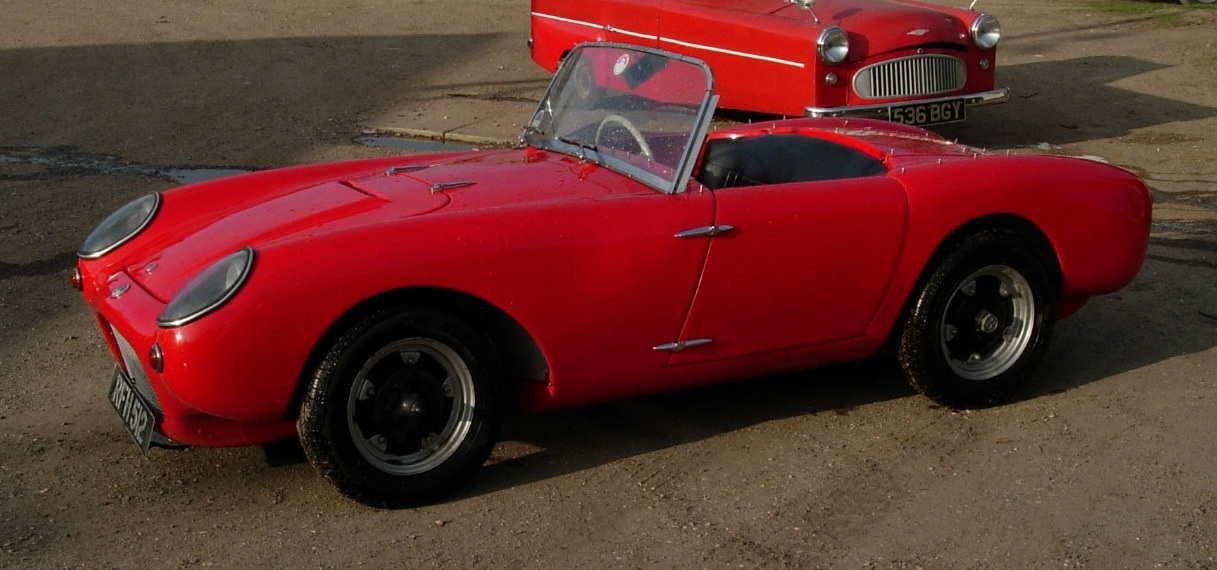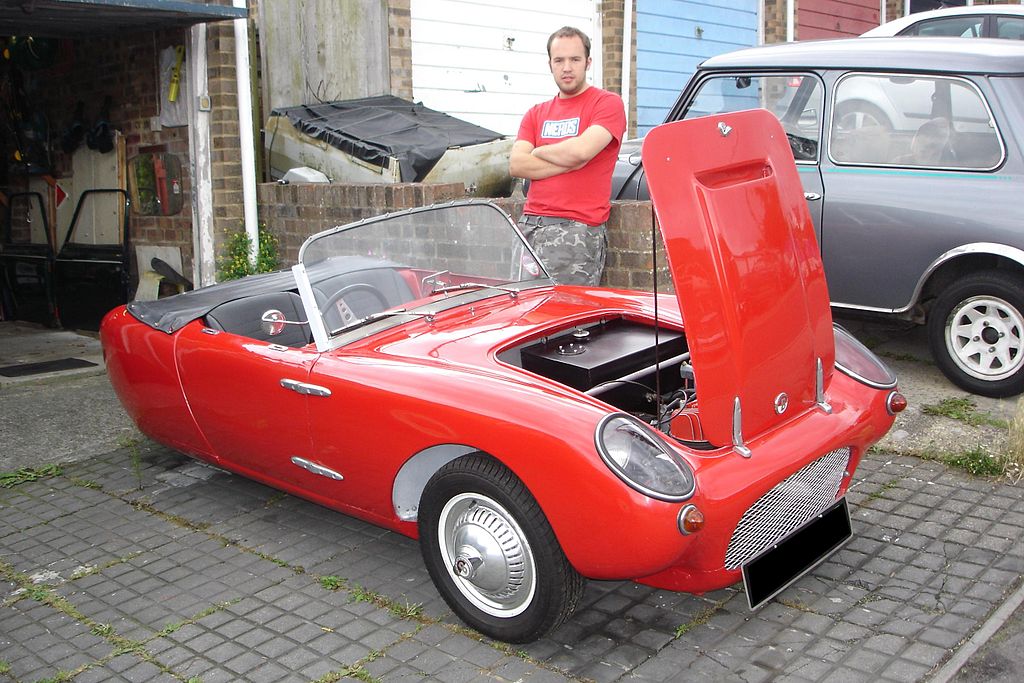Berkeley Cars Ltd /ˈbɑːrkliː/ of Biggleswade, Bedfordshire, England produced economical sporting microcars with motorcycle-derived engines from 322 cc to 692 cc and front wheel drive between 1956 and 1960
The Berkeley automobile was a collaboration between designer Lawrence "Lawrie" Bond and the Berkeley Coachworks factory owned by Charles Panter, which at the time was one of the largest manufacturers of caravans in Europe. It was an ideal project for Berkeley, who had developed considerable skills in the use of Glass-reinforced plastic (GRP), and were looking for something to fill the gaps in the very seasonal caravan market. What Panter and Bond wanted to achieve was "something good enough to win World 750cc races... but cheap, safe, easily repairable and pretty."
The early cars were an immediate success on the home market, and several derivative models were spawned over the four years of car production. Export markets, most notably the United States, were exploited and the cars earned a reputation for fun, if fragile, sports motoring on a budget. Recognising the threat posed by the newly introduced Mini and Austin-Healey Sprite in the late fifties, the company started to develop are a more conventional model with the support of Ford.
The caravan market collapsed towards the end of 1960, and Berkeley's poor cash flow forced the company into liquidation on 12 December 1960, taking its car manufacturing activities with it. After having produced about 4100 cars of various types, the workforce was laid off shortly before Christmas that year. An attempted sale of the company to Sharp's Commercials Ltd (manufacturer of the Bond Minicar) came to nothing, and the company's assets were liquidated in 1961.
The factory was later used by Kayser Bondor Ltd to make women's underwear, but it was demolished in 2002 and the site turned over to housing. A road named 'Berkeley Close' in the housing estate provides the only obvious link to the car factory.
Today there is an active owner's club (the Berkeley Enthusiasts' Club), which provides a range of parts and services aimed at preserving the remaining few hundred cars known to survive worldwide.
Sports (SA322)
Berkeley's first production car was the 'Sports' (type SA322), announced in September 1956 and produced from October 1956 to January 1957. Production began with two prototypes (registered RMJ395 and RMJ946), which were seen being tested with enthusiasm around the neighbourhood of Biggleswade in the late summer of 1956. Stirling Moss drove one at Goodwood in September, and the car was launched to the public at the 1956 London Motor Show – one year ahead of the Lotus Elite, which was also to be of fibreglass monocoque construction.
Sports (SE328)
After 163 of the SA322 cars had been manufactured, a change was made to the SE328 model with a 328 cc Excelsior engine offering 18 bhp (13 kW; 18 PS). The production run ran from Jan 1957 to April 1958 with chassis numbers from 164 to 1422, many being exported to the United States where it sold for approximately $1600 (equivalent to $13.9 thousand today). The manufacture touted the number 70, meaning it could reach 70 mph and had an average fuel economy of 70 mpg. The export model was differentiated by having separate headlamps whereas on the home market they were faired into the wings, although the export type lamps could be specified.
Sports and Twosome (SE492)
In late 1957 a new derivative model was introduced, using a 30 bhp (22 kW; 30 PS), Excelsior three-cylinder 492 cc engine with triple carburettors. This engine configuration was made possible by the vertically split crankcase of the Excelsior engine and modular crankshaft and barrels, which made adding a central cylinder relatively easy. A four speed gearbox was standardised. The top speed was now 80 mph (130 km/h). The production ran from October 1957 to March 1959 with chassis numbered 1 to 666. From about October 1958, in order to coincide with the introduction of the 'Foursome' (see below), they were renamed the ‘Twosome’. Also at the 1958 Motor Show a Fixed Head (or Hardtop) was announced and displayed that had external as well as the usual internal door handles, but there are no records that this body style actually reached production.
Foursome
Announced in October 1958, this model was wider and longer than its forebears and differed structurally in that the rear swinging arms were lower and external to the body, and the spare wheel was mounted at the rear of the car. The type reference is supposed to be SE492/4 but one has the reference B.100. The chassis numbers are D1/1 to D1/19 but then again one example has D1/100, this particular car could be the prototype since it appears in publicity pictures.
B95 and B105
The B95 and B105 models were launched at the 1959 Geneva Motor Show and boasted more power from twin-cylinder Royal Enfield 692 cc four-stroke engines, with the 40 bhp (30 kW; 41 PS) Super Meteor engine in the B95 and the 50 bhp (37 kW; 51 PS) Constellation unit in the B105 which could reputedly exceed the magic 100 mph (160 km/h). The engines featured Berkeley-design primary chain cases to accommodate a Lucas Bendix starter motor, an external Lucas dynamo mounted above the gearbox, and a duplex (or double-row) chain drive to the differential. Kerb weight increased to 402 kg (886 lb). B95 engine numbers have the unique prefix 'SMTB', while B105 engines are prefixed 'SMUA'.
T60
Surprisingly late-on in the British microcar boom of the 1950s, Berkeley's only three-wheeler model was not introduced until September 1959. It was an instant success in the UK where three-wheelers could legally be driven on a motorcycle licence, so were suitable for a motorcyclist with family. Another advantage was that the purchase and road tax fees for three-wheelers cost considerably less than four-wheeled vehicles. Thus at its launch, the T60 only cost £400 (equivalent to £8.54 thousand today).
Bandit
For 1961 the intention was to move into the mainstream sportscar market with the Bandit designed by John Tojeiro. This was to be powered by the 997 cc Ford engine (as in the 105E Anglia) with Berkeley-designed MacPherson strut front and independent rear suspension. The car had a complex sheet steel chassis, braced by a GRP floor which was riveted to it, and boasted 8in diameter Girling disc brakes at the front. This made the design more conventional than earlier models, but still retaining a distinctive design and relatively light weight.
















No comments:
Post a Comment